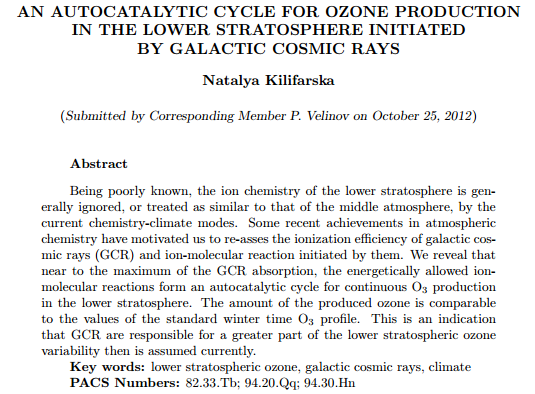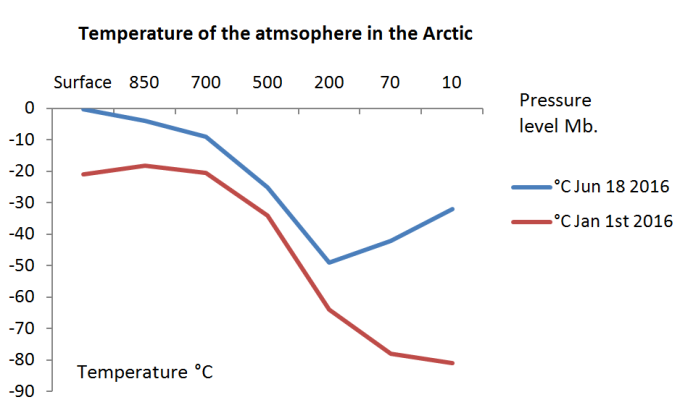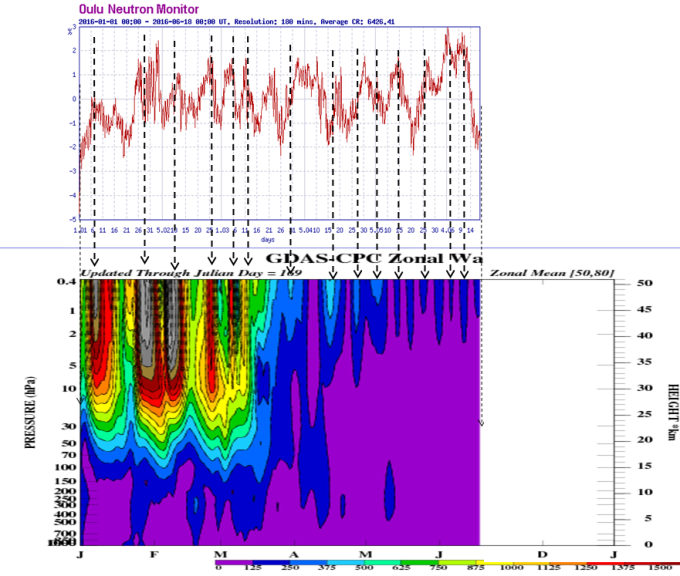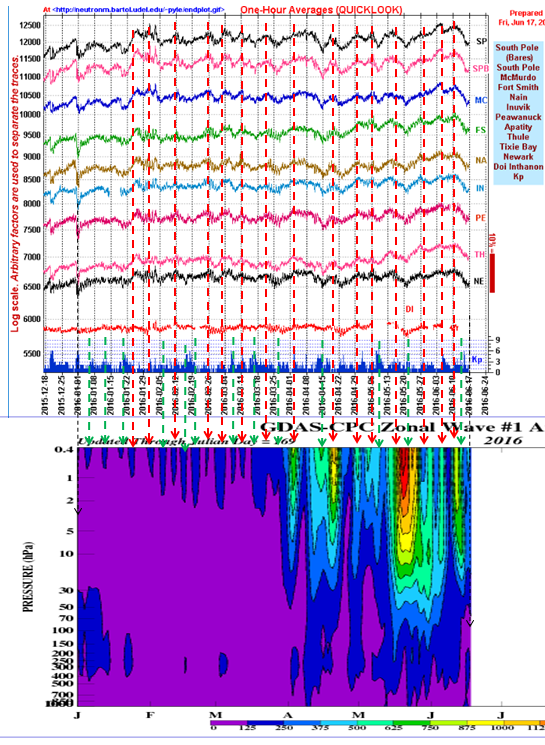Recent research suggests that there is a pathway for the generation of ozone at the poles via ionisation of the atmosphere by cosmic rays.

From the conclusion: recent modelling shows that the O3 distribution in the extra-tropics is formed mainly from the local production, while the impact of the tropical ozone, transported by stratospheric dynamics, is substantially smaller. During winter conditions, when the amount of solar UV radiation at middle and high latitudes is strongly reduced, the only alternative source of O3 at these latitudes are highly energetic galactic cosmic rays (GCR) capable of penetrating into the lower stratosphere and troposphere.
However, the influence of GCR on the lower stratosphere has been ignored for a
long time, thought to be negligible at these levels. Through reassessment of the efficiency of main atmospheric constituents’ ion-ization by GCR and the ion-molecular reactions between the most abundant ions and neutrals, we have shown an existence of an autocatalytic cycle for continuous O3 production in the lower stratosphere and upper troposphere (near the level of maximal absorption of GCR, known as Pfotzer maximum). The quantity of O3, produced by the positive ion chemistry, has the same order of magnitude as the mid-latitude steady-state ozone profile. This is an indication that the lowermost ozone profile could be substantially distorted by the highly energetic particles.
If Cosmic Rays can result in ozone production at the poles it links solar activity and climate in a direct and powerful fashion. Ozone drives of the evolution of planetary winds and cloud cover from the winter hemisphere. The signature of its activity is written into the surface temperature record.
Don’t hold your breath while you wait for climate scientists to adopt these ideas. The current generation of climate scientists have no interest in discovering the origins of natural modes of climate variation even though these modes have been in operation since the dawn of time. Some proponents of the anthropocentric global warming argument now maintain that all climate change (of whatever description) is due to the impact of man on the planet. For others the origin of natural modes of climate variation must remain mysterious and unknowable. If it seems that something out of the ordinary happens it must be ‘an internal oscillation’ or the result of ‘an exchange of energy between the ocean and the atmosphere’, neither of long term consequence unless it can be suggested that these internal modes are getting out of whack due to the influence of man.
This seems to be the current point of view. Mans responsibility, for the good of succeeding generations, is to avoid warming, cooling, drought, flood, damaging radiation, big tides, big waves and typhoons by reducing carbon emissions. Carbon dioxide, the raw material for plant photosynthesis, the original building block for life on the planet, is nasty. The imperative is to stop emitting carbon dioxide wherever we can in order to stop ‘climate change’. The words ‘climate change’ now equates to ‘the addition of carbon dioxide to the atmosphere due to the activities of man in burning fossil fuels’. If its not scarce, we must nevertheless avoid burning it. We must reduce our energy use to that which is sustainable, not in terms of the amount of the resource available but in terms of the desired state of the atmosphere. If we have this resource we must keep it in the ground even though others are crying out for electric light and the means to do things other than by the sweat of their brow. We will deny them the use of coal for their own good.
Originally, the notion was that the planet warmed when CO2 levels increased. Now, in the absence of warming, carbon dioxide is responsible for change in the status quo. Where have we heard this sort of argument before?
It is in the nature of those who hold strong ideas that they will seek to reward and give preferment to those who agree with them.
It is those who can capture our imaginations who will be paid from the public purse to do so again and again. Adolph Hitler and Tim Flannery. ‘Mein Kampf’ and ‘The Weather Makers’. The free lunch. Give the man a Beer. Let’s recommend him for a Nobel. Al Gore, ‘An Inconvenient Truth’. Do something for the planet. Stop breathing.
WHAT ARE COSMIC RAYS?
Wikipedia: Cosmic rays are immensely high-energy radiation, mainly originating outside the Solar System.They may produce showers of secondary particles that penetrate and impact the Earth’s atmosphere and sometimes even reach the surface. Composed primarily of high-energy protons and atomic nuclei, they are of mysterious origin. Data from the Fermi space telescope (2013) have been interpreted as evidence that a significant fraction of primary cosmic rays originate from the supernovae of massive stars. However, this is not thought to be their only source. Active galactic nuclei probably also produce cosmic rays.
The kinetic mass-energy of massive particles can increase drastically due to relativistic effects. Through this process, the particles can acquire tremendously high energies, significantly higher than those of even the highest-energy photons detected to date (whose energy depends solely on frequency and not on speed, as photons always travel at the same speed). The Oh-My-God particle, the highest-energy fermionic cosmic ray detected to date, had an energy of about 3×1020 eV, while the highest-energy gamma rays to be observed, very-high-energy gamma rays, are photons with energies of up to 1014 eV. Hence, the highest-energy detected fermionic cosmic ray was around 3×106 times more energetic than the highest-energy detected cosmic photons.
Of primary cosmic rays, which originate outside of Earth’s atmosphere, about 99% are the nuclei (stripped of their electron shells) of well-known atoms, and about 1% are solitary electrons (similar to beta particles). Of the nuclei, about 90% are simple protons, i. e. hydrogen nuclei; 9% are alpha particles, identical to helium nuclei, and 1% are the nuclei of heavier elements, called HZE ions. A very small fraction are stable particles of antimatter, such as positrons or antiprotons. The precise nature of this remaining fraction is an area of active research. An active search from Earth orbit for anti-alpha particles has failed to detect them.
Ultra-high-energy cosmic rays have energies comparable to the kinetic energy of a 90-kilometre-per-hour (56 mph) baseball.
When cosmic rays enter the Earth’s atmosphere they collide with atoms and molecules, mainly oxygen and nitrogen. The interaction produces a cascade of lighter particles, a so-called air shower secondary radiation that rains down, including x-rays, muons, protons, alpha particles, pions, electrons, and neutrons.
Typical particles produced in such collisions are neutrons and charged mesons such as positive or negative pions and kaons. Some of these subsequently decay into muons, which are able to reach the surface of the Earth, and even penetrate for some distance into shallow mines. The muons can be easily detected by many types of particle detectors, such as cloud chambers, bubble chambers or scintillation detectors.
MEASUREMENT OF THE INCIDENCE OF COSMIC RAYS
Wikipedia: In 1912, Victor Hess carried three enhanced-accuracy Wulf electrometers to an altitude of 5300 meters in a free balloon flight. He found the ionization rate increased approximately fourfold over the rate at ground level. Hess ruled out the Sun as the radiation’s source by making a balloon ascent during a near-total eclipse. With the moon blocking much of the Sun’s visible radiation, Hess still measured rising radiation at rising altitudes. He concluded “The results of my observation are best explained by the assumption that a radiation of very great penetrating power enters our atmosphere from above.” In 1913–1914, Werner Kolhörster confirmed Victor Hess’ earlier results by measuring the increased ionization rate at an altitude of 9 km.
Hess received the Nobel Prize in Physics in 1936 for his discovery.
Flying 12 kilometres (39,000 ft) high, passengers and crews of jet airliners are exposed to at least 10 times the cosmic ray dose that people at sea level receive. Aircraft flying polar routes near the geomagnetic poles are at particular risk.
DEPENDENCY OF COSMIC RAYS ON THE ACTIVITY OF THE SUN
The flux of incoming cosmic rays at the upper atmosphere is dependent on the solar wind, the Earth’s magnetic field, and the energy of the cosmic rays. At distances of ~94 AU from the Sun, the solar wind undergoes a transition, called the termination shock, from supersonic to subsonic speeds. The region between the termination shock and the heliopause acts as a barrier to cosmic rays, decreasing the flux at lower energies (≤ 1 GeV) by about 90%. However, the strength of the solar wind is not constant, and hence it has been observed that cosmic ray flux is correlated with solar activity.
In addition, the Earth’s magnetic field acts to deflect cosmic rays from its surface, giving rise to the observation that the flux is apparently dependent on latitude, longitude, and azimuth angle. The magnetic field lines deflect the cosmic rays towards the poles, giving rise to the aurorae.

RELATIONSHIP BETWEEN COSMIC RAYS AND SUDDEN STRATOSPHERIC WARMINGS
Citation: Osprey, S., et al. (2009), Sudden stratospheric warmings seen in MINOS deep underground muon data as reported here: http://discovery.ucl.ac.uk/148293/1/2008GL036359.pdf
The rate of high energy cosmic ray muons as measured underground is shown to be strongly correlated with upper air temperatures during short-term atmospheric (10-day) events. The effects are seen by correlating data from the MINOS underground detector and temperatures from the European Centre for Medium Range Weather Forecasts during the winter periods from 2003– 2007. This effect provides an independent technique for the measurement of meteorological conditions and presents a unique opportunity to measure both short and long-term changes in this important part of the atmosphere.
Do you think you could explain all that to your grandmother while its still fresh in your mind?
RELATIONSHIP BETWEEN THE INCIDENCE OF COSMIC RAYS AND GEOPOTENTIAL HEIGHT ANOMALIES IN THE ARCTIC IN 2016
In winter the upper atmosphere is colder due to the descent of very cold ozone deficient air from the mesosphere. 
The displacement of this core of cold air by a mushrooming ascent of ozone rich air results in much higher temperatures over the polar cap. The mushrooming effect centres on about 50° of latitude as ozone is gathered in zones of low surface pressure associated with warm ocean surfaces initiating wholesale ascent. When the ascending air reaches 30 hPa, 10 hPa and 1 hPa it spreads laterally to occupy the region of the polar cap. This has been a ‘mystery’ for climate science for a generation of more. It appears that warming air is not connected with the presence of ozone in the minds of many observers. Are they turning a blind eye? Are they incapable of rigorous inquiry? Do they simply assume that the temperature of the air is the result of the absorption of short wave radiation from the sun? Is this commonly seen assertion a required article of faith? Who knows?
The warming of the stratosphere is tracked via the increase in geopotential height between 50 and 80 degrees of latitude as seen in the diagram below. For the purposes of comparison I have lined up data for cosmic rays and geopotential height anomalies across a common time interval.The question is this: are these two data streams related?
RELATIONSHIP BETWEEN THE INCIDENCE OF COSMIC RAYS AND GEOPOTENTIAL HEIGHT ANOMALIES

The period extends from January to mid June in 2016. On the face of it, galactic cosmic rays could be making a contribution to the periodic proliferation of ozone resulting in episodic increases in geopotential height.There are enough coincidences to suggest that this might be the case. The fact that these increases are much greater in winter is consistent with the ease of disturbance of the polar atmosphere at a time of the year when temperature is at a low base, the connection to the mesosphere is tenuous and dependent on atmospheric pressure. Winter is the time of the year where ozone proliferates. But, we must note that there are warming events that are not associated with the incidence of galactic cosmic rays and that peaks in GCR activity do occur without an obvious atmospheric response. Plainly there is another factor involved that may compete with or perhaps complement the activity of GCR.
The loss of surface pressure over Antarctica over the last seventy years represents a one way transfer of atmospheric mass from high southern latitudes that requires an external driver capable of retaining atmospheric mass against the force of gravity. The only force capable of retaining new states of this sort is electromagnetic. If there is indeed a response to electromagnetic effects it should be seen at times when geomagnetic activity is high.
In the diagram below that relates to the southern pole we can see that peaks in the solar wind, as indicated by the Kp Index (lowest series) are not necessarily conjunctional with peaks in neutron counts. In fact in many instances, neutron counts are in a trough as the kP index peaks.

The green lines in the diagram locate instances where there is an atmospheric response that is conjunctional with geomagnetic activity in the absence of cosmic ray activity. If we combine the incidences where cosmic ray indices peak in conjunction with increased GPH with the instances where the kP index peaks in conjunction with increases in GPH we can account for each and every heating episode.
CONCLUSION
This analysis is consistent with the notion that both the solar wind and cosmic rays can be independently influential in determining the partial pressure of ozone engendering an increase in geopotential height. If geomagnetic activity slows the zonal wind that acts to reduce the influx of mesospheric air, then ozone partial pressure will increase and the geopotential height response will appear. If cosmic rays enhance ionisation and ozone is produced this will have the same effect.If the atmosphere warms due to the slowing of the zonal wind then the the galactic cosmic ray enhancement of ozone cuts in in every instance regardless of whether there is a conjunctional peak in galactic cosmic ray activity. So, these conditioning influences do tend to work hand in hand in a complementary fashion and equally, they can conflict.
The limit to the shifts in atmospheric mass, however engineered, is set by gravity. The extent to which this process is capable of establishing different states,so far as surface pressure is concerned, depends upon the pressure of the solar wind, known to vary on 100 and 200 year time scales. The existence of the phenomenon whereby atmospheric mass shifts over long time scales tells us that external influences are involved.
All fluctuations in climate on all time scales from the very short to the very long, whether we see them as internal fluctuations or externally imposed, can be described in terms of surface atmospheric pressure, wind and cloud cover. It is the circulation at the poles in winter that drives these changes, not the relatively invariable rate of heating in near equatorial latitudes. Climate science is turned on its head.
Hi Erl
Nice work.
It is interesting that EUV fluctuates tenfold during
the 11 year solar cycle and cosmic rays are strongest
during solar minimum. Does EUV and GCR strength
alternate? That would make things more complicated.
LikeLike
Thanks TL Mango. High EUV is related to strong sunspot activity. The current collapse in atmospheric density in the ionosphere and the thermosphere is due to weakening EUV. So, we should see a stronger impact of Cosmic Rays on the ozone content of the air. According to Livingstone and Penn sunspots will soon disappear entirely. http://science.nasa.gov/science-news/science-at-nasa/2009/03sep_sunspots/
https://wattsupwiththat.com/2009/08/15/livingston-and-penn-in-eos-are-sunspots-different-during-this-solar-minimum/
LikeLike
Do you have some reference for the term “geopotential height”, used 10 times in this article without meaning? Is this a ‘gravity-adjusted height’, some sort of fake gravitational potential of atmospheric mass, or the fake meteorological ‘would be’ temperature at the surface, created by adding some nonsense dry laps rate to the measured temperature?
High Solar EUV still converts more O2 + H2O to O3 + H2, increasing the sensible heat, as indicated by temperature of all atmosphere above the tropopause. Same number of molecules, but higher temperature a yields lower density, higher outer volume. The reverse is true with low solar EUV. But you claim some collapse in ‘density’ in the ionosphere! What can you possibly mean? Just what can “Cosmic Rays” do to this planet’s outer atmosphere that solar EUV is not doing better?
LikeLike
Try Wikipedia.
LikeLike
Is there any relation between ozone layer and occurrence of maximum cosmic rays intensity at 15-25 km?
LikeLike
Cosmic rays ionise the air and enable the formation of more ozone.
LikeLike
What is the intensity of highest-energy cosmic rays? Is the energy of the order 10^20 eV ?
My email: htg@interia.pl
LikeLike
Thanks for your interest.
You ask
What is the intensity of highest-energy cosmic rays? Is the energy of the order 10^20 eV ?
I don’t know. One can see answers here: https://en.wikipedia.org/wiki/Ultra-high-energy_cosmic_ray
What I do know is these rays have more ionizing power than short wave ionizing radiation from the sun that is seasonally diminished in winter when ozone partial pressure in the atmosphere increases. I have seen claims that cosmic rays play a role in this increase.
However, it could simply be that ozone persists in winter due to the reduction in the incidence of the wave lengths to which it is susceptible due simply to low sun angles.
LikeLike